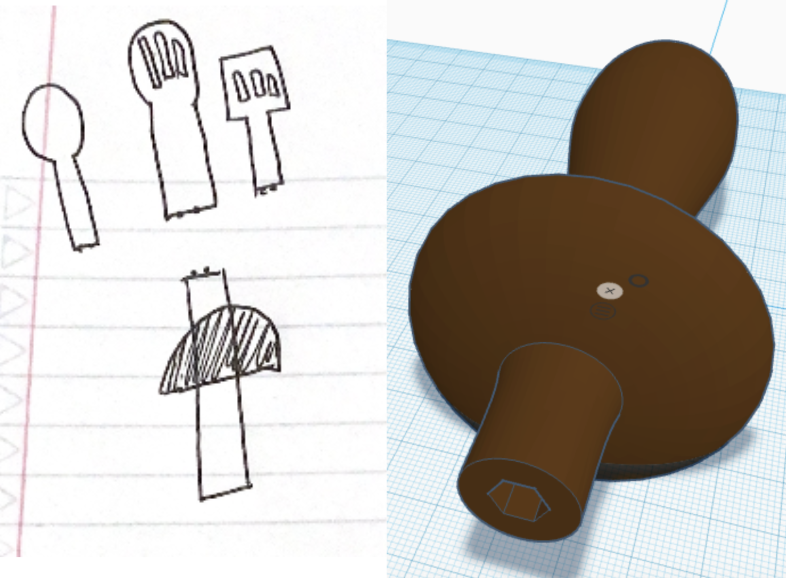For my kitchen tool project, the top five specifications I prioritize revolve around functionality, usability, aesthetics, and durability. Firstly, interchangeability is a must. The ability to switch between different utensil heads, such as a spatula to a spoon or a fork, adds versatility and convenience to the tool, making it useful in many cooking tasks with just one device. This interchangeability ensures that users can tackle different culinary needs without cluttering their kitchen with multiple tools. This is also the main point of the project, so it is crucial for the prototype to have this capability.
Secondly, the ease of switching the top part is important to ensure fast and simple transitions between utensil functions. A simple and intuitive mechanism for attaching and detaching the utensil heads enhances user experience, eliminating the frustration and wasted time associated with complicated switching processes. This specification emphasizes the importance of user-centered design, prioritizing efficiency and ease of use in the kitchen environment. I plan on achieving this by using magnets, making the transitions an easy task.
Thirdly, comfort is a key consideration in the design of the kitchen tool. The handle should be ergonomically designed in order to enhance the user’s experience, making the process of using the tool a comfortable experience. A comfortable handle enhances user satisfaction and encourages prolonged use of the tool, which is crucial.
Fourthly, aesthetics play a significant role in the appeal of the kitchen tool. A cool design not only enhances the visual appeal of the product but also reflects its innovative functionality. A visually appealing tool also adds a touch of style to the kitchen.
Lastly, longevity is essential to ensure that the kitchen tool withstands the rigors of regular use and maintains its functionality over time. High-quality materials and robust construction are essential to ensure durability and longevity, prevent premature wear and tear, and ensure the tool remains reliable. By prioritizing these top five specifications, I aim to create a kitchen tool that combines functionality with style, enhancing the cooking experience for users while ensuring lasting value and satisfaction.

Prototype idea

Switching mechanism
In developing this project, several constraints must be carefully considered to ensure the project’s success. Firstly, time is a critical constraint, particularly because I have to balance this project with other classes and projects. I will have to use my time efficiently to make progress when I have time.
Secondly, the skill required to utilize a 3D printer presents a significant constraint. While 3D printing is somewhat straightforward, it needs proficiency in digital modeling software and printer operation. Since I don’t have much experience with CAD or modeling, I will first need to improve my skills in these areas to then be able to print.
Thirdly, proficiency in woodworking skills is crucial, particularly if the aesthetic I’m going for the kitchen tool is rustic. Achieving a rustic aesthetic often involves working with wood, requiring precision in cutting, shaping, and finishing techniques. I have never worked with wood before and I am still unsure about how I should approach making the top parts of the tool, so I will need to learn some new skills.
Fourthly, material quality is a key constraint that directly impacts the tool’s longevity and usability. Selecting high-quality materials that can withstand the rigors of kitchen use, such as heat, moisture, and repeated handling, is essential for creating a durable and reliable product.
Lastly, achieving the desired rustic aesthetic presents a unique constraint that requires careful consideration throughout the design and manufacturing process. This constraint involves balancing aesthetic preferences with functional requirements while ensuring consistency in the tool’s appearance and texture. By addressing these top five constraints, I hope that I can achieve the successful development of the kitchen tool project.

Woodshop [1]
References:
[1] “Woodshop.” Woodshop | City and County of Broomfield – Official Website, www.broomfield.org/3937/Woodshop. Accessed 1 Apr. 2024.


1 Comment. Leave new
Hi Ari,
This is an interesting idea! I was intrigued by the idea of a universal kitchen tool, it brought me back to the “sporks” of elementary school past. I saw that you are looking to use CAD and 3D printing, but also mentioned woodworking. Which one will you be using for the universal handle? Or will it be a combination of both?